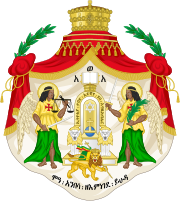
Menelik II, baptised as Sahle Maryam was king of Shewa from 1866 to 1889 and Emperor of Ethiopia from 1889 to his death in 1913. At the height of his internal power and external prestige, the process of territorial expansion and creation of the modern empire-state was largely completed by 1898.

Lij Iyasu was the designated Emperor of Ethiopia from 1913 to 1916. His baptismal name was Kifle Yaqob. Ethiopian emperors traditionally chose their regnal name on the day they were crowned, and since he was never crowned, he is usually referred to as Lij Iyasu, "Lij" meaning child, especially one born of royal blood.

Zewditu was Empress of Ethiopia from 1916 until her death in 1930. The first female head of an internationally recognized country in Africa in the 19th and 20th centuries, and the first and only empress regnant of the Ethiopian Empire, her reign was noted for the reforms of her Regent and designated heir Ras Tafari Makonnen, about which she was at best ambivalent and often stridently opposed, due to her staunch conservatism and strong religious devotion. She is the most recent empress regnant, as well as the last female Ethiopian head of state until the 2018 election of Sahle-Work Zewde as president.
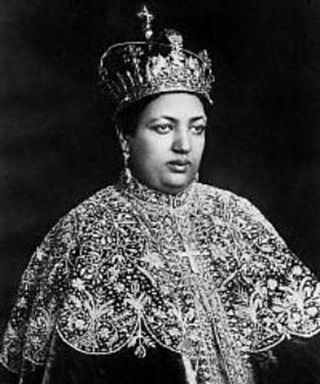
Menen Asfaw was Empress of Ethiopia as the wife of Emperor Haile Selassie.

The Solomonic dynasty, also known as the House of Solomon, was the ruling dynasty of the Ethiopian Empire from the thirteenth to twentieth centuries. The dynasty was founded by Yekuno Amlak, who overthrew the Zagwe dynasty in 1270. His successors claimed he was descended from the legendary king Menelik I, the supposed son of the biblical King Solomon and the Queen of Sheba, in order to legitimize the dynasty's assumption of power. Although this claimed ancestry gave the dynasty its name, there is no credible evidence that the dynasty was descended from Solomon or the Davidic line. The Solomonic dynasty remained in power until 1974, when its last emperor Haile Selassie was overthrown by a coup d'état.

Until the end of the Ethiopian monarchy in 1974, there were two categories of nobility in Ethiopia and Eritrea. The Mesafint, the hereditary royal nobility, formed the upper echelon of the ruling class. The Mekwanint were the appointed nobles, often of humble birth, who formed the bulk of the aristocracy. Until the 20th century, the most powerful people at court were generally members of the Mekwanint appointed by the monarch, while regionally, the Mesafint enjoyed greater influence and power. Emperor Haile Selassie greatly curtailed the power of the Mesafint to the benefit of the Mekwanint, who by then were essentially coterminous with the Ethiopian government.
Princess Yeshashework Yilma was the daughter of Dejazmatch Yilma Makonnen, governor of Harar and niece of Emperor Haile Selassie of Ethiopia. Her mother Woizero Aselefech Wolde Hanna was the niece of Empress Taitu Bitul, consort of Emperor Menelik II of Ethiopia. Through her paternal great-grandmother, she was a member of the Imperial Solomonic dynasty of Ethiopia. Her father died while she was still very young.

Darge Sahle Selassie, also known by his horse name Abba Gersa, was a 19th-century Ethiopian nobleman, provincial governor, general, and a trusted councillor to his nephew, Emperor Menelik II.
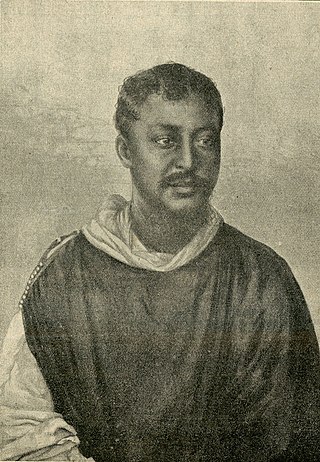
RasMengesha Yohannes was governor of Tigray and a son of Emperor Yohannes IV. His mother was Welette Tekle Haymanot wife of dejazmach Gugsa Mercha. Ras Araya Selassie Yohannes was his younger half brother. Prior to the Battle of Metemma, Mengesha Yohannes was considered to be a nephew of Emperor Yohannes IV. During the battle, the Emperor was mortally wounded and it was on his deathbed that Mengesha Yohannes was acknowledged as his "natural" son and designated as his heir. This created something of a succession problem.

RasDesta Damtew KBE was an Ethiopian noble, army commander and a son-in-law of Emperor Haile Selassie I. He is known for his leadership in the Ethiopian Army during the Second Italo-Ethiopian War. He was executed on 24 February 1937, by the Italian Armed Forces shortly after Ethiopia's loss in the war.

RasMulugeta Yeggazu was an Ethiopian government official, who served in the first cabinet formed by Emperor Menelik II. He served as Imperial Fitawrari, Commander of the Mahel Sefari of the Ethiopian Army during the Second Italo-Ethiopian War.

DejazmachBalcha Safo, popularly referred to by his horse-name Abba Nefso, was an Ethiopian military commander and lord protector of the crown, who served in both the First and Second Italo-Ethiopian Wars.
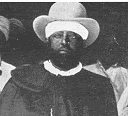
Gugsa Welle, was an Ethiopian army commander and a member of the imperial family of the Ethiopian Empire. He represented a provincial ruling elite which was often at odds with the Ethiopian central government.

Seyoum Mengesha KBE was an army commander and a member of the royal family of the Ethiopian Empire.

NegusMikael of Wollo, was an army commander and a member of the nobility of the Ethiopian Empire. He was the father of the "uncrowned" Emperor Lij Iyasu, and the grandfather of Empress Menen, wife of Emperor Haile Selassie. He changed his name to Mikael upon converting to Christianity.
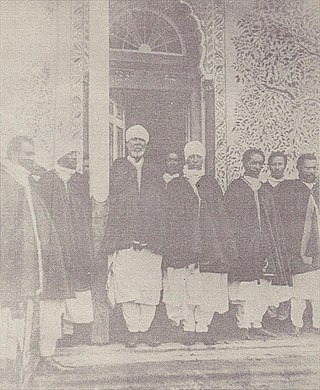
Gugsa Araya Selassie was an army commander and a member of the royal family of the Ethiopian Empire.
Hailu Tekle Haymanot, also named Hailu II of Gojjam, was an army commander and a member of the nobility of the Ethiopian Empire. He represented a provincial ruling elite who were often at odds with the Ethiopian central government. Hailu Tekle Haymanot was an independent-minded potentate who, throughout his life, was mistrustful of and mistrusted by the Emperor.
Ayalew Birru, or Ayyalaw Birru, was an Ethiopian army commander, a patriot, and a cousin of Emperor Haile Selassie I.

LijSeifu Mikael was an Ethiopian royal, member of the Solomonic dynasty from the House of Solomon that descended from the ancient Kingdom of Aksum, belonging to the branch of the aristocratic Amhara family from Ankober Shewa. He was the great-grandson of King Sahle Selassie of Shewa and his wife Queen Bezabish Dejene of Gojjam through his grandfather, Dejazmatch Mekuria Tesfaye of Gerim Gabriel, a first cousin of Emperor Menelik II of Ethiopia.
